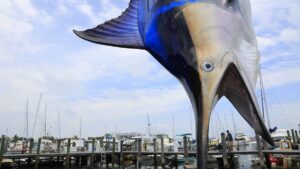End in sight as Opthea looks to be key player in US$10 billion wet AMD market

Pic:Getty Images
- Opthea look to transform standard of care treatment for wet AMD to improve vision outcomes
- Two Phase 3 trials are underway investigating lead drug OPT-302 with results from both forecast mid 2025
- Opthea looking to be first drug statistically to improve vision for sufferers of wet AMD since launch of LUCENTIS in 2006
Retinal diseases focused biotech Opthea (ASX:OPT) is looking to provide the biggest improvement to standard of care in almost 20 years for wet age-related macular degeneration (wet AMD), a leading cause of blindness in the aged population.
OPT recently announced completion of patient enrolment in its first pivotal Phase 3 trial (COAST) investigating sozinibercept (OPT-302), a vascular endothelial growth factor (VEGF)-C/D inhibitor in combination with aflibercept, an anti-VEGF-A therapy, for the treatment of wet AMD.
The clinical program for OPT-302 comprises two Phase 3 pivotal trials, COAST and ShORe, with ShORe’s enrolment forecast to conclude in Q2 CY24. OPT plans to release topline results from both trials by mid-2025.
Stockhead this week caught up with OPT’s US-based management team visiting Australia, as it looks to disrupt the eye disease treatment landscape. CEO Dr Frederick Guerard and CFO Peter Lang both joined the biotech in October 2023,
Guerard boasts a pharmaceutical career exceeding 25 years. He was the Graybug Vision CEO, overseeing the clinical development of a late-stage wet AMD product and orchestrating its merger with CalciMedica, where he continues as a non-executive board member.
Guerard was also the worldwide business franchise head of ophthalmology at Novartis. Along with holding various leadership roles at the multinational pharmaceutical company he also played a key role in revitalising the product pipeline through strategic acquisitions and licensing transactions in areas such as dry eye, presbyopia, and inherited retinal diseases.
Lang has more than 25 years of experience in strategic, operational, and financial solutions with extensive expertise in healthcare and biopharmaceuticals. His leadership spans roles in biopharmaceutical companies and renowned global and boutique investment banks.
Before joining OPT, Lang was CFO of Aerie Pharmaceuticals, where he played a key role in the successful strategic and financial repositioning of the company, leading to its acquisition by Alcon AG for ~US$950 million.
He was MD and partner at Ridge Advisory and has held leadership roles in healthcare investment banking at HSBC, Bank of America Merrill Lynch, UBS Investment Bank, and Leerink Partners.
Potential to provide superior clinical results
First a little background on AMD. There are two types of AMD – wet and dry. Dry AMD happens when the macular gets thinner with age in three stages including early, intermediate, and late.
Wet AMD is a less frequent form of late-stage dry AMD typically leading to accelerated vision deterioration.
Guerard says wet AMD happens when abnormal blood vessels grow in the back of the eye and damage the macula, usually causing faster vision loss.
“It forms for reasons we don’t know and distorts the vision,” he says.
“Patients wake up in the morning and they have a black spot in the middle of their vision and if not treated early and aggressively with existing standard of care patients will go blind.
“It’s very impactful because sufferers lose the centre of their vision so they can’t drive a car or even see their family properly.”
He says thankfully medications have been developed to address wet AMD but what OPT aims to do is add in their drug to existing treatments for better vision outcomes.
Complement current wet AMD treatment
In technical terms OPT-302 is a soluble form of vascular endothelial growth factor receptor 3 (VEGFR-3) expressed as an immunoglobulin G1 (IgG1) Fc-fusion protein. It is injected into the eye, along with current treatments for wet AMD.
OPT-302 binds and neutralises the activity of VEGF-C and VEGF-D on their endogenous receptors, VEGFR-2 and VEGFR-3.
Studies show that blocking VEGF-C and VEGF-D can inhibit the growth of blood vessels and prevent vascular leakage, addressing key factors in the pathophysiology of retinal diseases, including wet AMD.
“It’s an injection you get on a regular basis, which could be as often as every four, eight or 20 weeks depending on the patient,” Guerard says.
OPT’s Phase 2b trial met its pre-specified primary efficacy endpoint of a statistically significant improvement in visual acuity for patients treated with OPT-302 combined with standard of care LUCENTIS (ranibizumab) compared to ranibizumab alone.
Furthermore, secondary outcomes also included an increase in participants experiencing gains of 10 or more letters in vision, improved anatomy marked by reduced swelling and vascular leakage, all while maintaining a favourable safety profiles.
Significant market opportunity
Guerard says there are currently 3.5 million patients with wet AMD between the US, Europe, Australia and Canada receiving treatment who could all benefit fom OPT-302.
“Our drug could provide additional benefit to all these patients around the world,” he says.
“It’s a very, very large market and we estimated the sales of existing drugs in the wet AMD segment at over US$10bn for last year.
“We are not competing with any of these drugs but will be added to these drugs so the prospect for the investor is what we see as the biggest revolution in the quality of care of these patients in almost 20 years.”
He says no drug on the market today has delivered better vision acuity than LUCENTIS, which was approved by the FDA for wet AMD in 2006.
“That drug was a revolution and transformed the life of millions of patients by allowing them to see better and for longer,” he says.
“But of course what we are trying to do here is do better by combining another mechanism of action on top of LUCENTIS and that would be the first time in almost 20 years that a company has demonstrated better visual outcomes for the patients.”
Lang says subsequent drugs have also been launched since LUCENTIS but not improving visual acuity.
“There are other drugs which have been developed and approved like Eylea which reduce the number of injections that patients receive every year but they don’t improve vision,” he says.
OPT-302 is designed to work alongside these drugs and not aimed at replacing them.
“We are trying to be the first drug to improve vision statistically,” Lang says.
Guerard says OPT-302 has received fast track designation from the US FDA for the treatment of wet AMD.
While OPT is focusing firstly on the US it says it will also be looking at other markets for approval including Europe and countries like Australia.
“The US is indeed a very large market and approvals are fairly fast and you can launch just after and so we are focusing indeed quite a lot on the US,” Guerard says.
“The company is transitioning from being a small clinical stage organisation to a company that is preparing for a launch.”
The OPT share price is up 12.50% YTD.
The OPT share price today:
Related Topics

UNLOCK INSIGHTS
Discover the untold stories of emerging ASX stocks.
Daily news and expert analysis, it's free to subscribe.
By proceeding, you confirm you understand that we handle personal information in accordance with our Privacy Policy.








